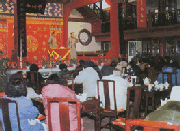Book-reading Teahouse

In old Beijing, book-reading teahouses were also very popular. In such teahouses, drinking tea was only a sideline, while listening to the storyteller (or book reading) or watching the Quyi(a traditional Chinese art form combining storytelling with music and performances) performances was the main event.
There were usually two performing periods: daytime and nighttime. During the day, the book reading or Quyi performance began at 3:00 - 4:00 pm, lasting for three to four hours until 6:00 - 7:00 pm. An hour later, the night shift started, which would last until midnight. Sometimes, there might be a mid-day performance between 1:00-3:00 pm.
Tea was sold prior to the beginning of the book reading or Quyi performances, but not after. Besides, it took money to listen to the reading, usually one copper coin for a chapter on average.
Acting as a link between tea and literature, the book-reading teahouses were most proper for the aged people, who could not only gain historical knowledge, but also achieve the purpose of entertainment and relaxation.
Wild Teahouse
Beijingers were fond of going on excursions to the suburbs throughout the year. In the places they most frequented, wild teahouses appeared. This kind of teahouses was almost always located in the suburbs bestowed with beautiful scenery, serving as a venue for both play and rest. The tables and chairs were usually very simple, with commonplace tea being sold instead of "Long Jing" or "Mao Jian." The enjoyable part about wild teahouses was the intoxicating countryside scene and flavor.
Wine Teahouse and Others

Wine teahouses, which, as the name indicates, sold tea and wine at the same time, were usually on a small scale, just providing a place for people to have a talk.
There were also chess teahouses, which were good places for play chess while enjoying tea. At any rate, people from all walks of life could find the proper teahouse for themselves. As a book once pointed out, the teahouses in fact had transformed from an entertainment venue for the rich people to a shelter from the reality for the perplexed and poverty-stricken people. For the most loyal of regular teahouse customers, enjoying each other's company in a relaxing atmosphere counted more than anything else.
In the 1930s, the outdoor teahouses in Zhongshan Park becamewent extremely famous, gradually replacing the traditional indoor teahouses. Beijingers were allowed to enjoy their tea in the park, which used to be limited to the royal members.
Nevertheless, after the founding of the Republic of China in 1911, the teahouses in Beijing as a whole began to go downhill, due to the whole country suffering from a great economic depression and social turmoil. Under such circumstances, it was hard to maintain the teahouses, which were operated with a small capital and little profit. By the time of the founding of the People's Republic of China in 1949, there were only several teahouses left in Beijing.










